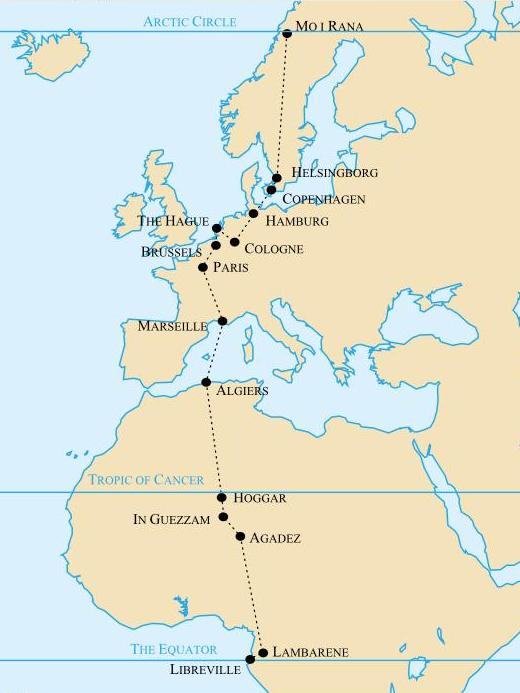
In the autumn of 1959, a 3-ton block of ice made an 8,500 kilometer journey on the back of a pickup truck from the edge of the Arctic Circle to the Equator in central Africa. The journey which took four weeks to complete involved driving through the vast desert of the Sahara in fifty degree heat. During this entire time no refrigeration was used.
The trip was a publicity stunt organized by a Norwegian company called Glassvatt, that manufactured insulating glass wool, to show how good their product was.
The idea for the ice block expedition was sown the previous autumn by Radio Luxembourg when they challenged anyone to transport three tons of ice from the Arctic Circle to the Equator. The condition was that no form of refrigeration should be used. Confident that no one would be able to pull this off, the station announced a reward of 100,000 francs for each kilogram that remained at the destination. This was equivalent to about $17,000 per kg in 2019 currency, which was a lot of money.
Birger Natvik, the managing director at the Norwegian insulation material company Glassvatt (today Glava AS) saw the announcement and suggested that the company take on the challenge. Natvik figured that if they carefully wrapped the ice with glass wool made from fibreglass they could minimize ice melt, and the company could stand to make several hundred million in francs.

Glassvatt declared that they accept the challenge, and at once there was a furor across the nation. People debated how much ice would be lost in the journey, and the media speculated how much money the company was staked to make. When Radio Luxembourg realized their folly and the potential loss they faced, they retracted the offer. By this point, however, the planned expedition had received so much attention that Glassvatt decided to go through with it anyway. They decided that the expedition would be an opportunity to show the quality of their insulation material. Other companies also wanted to be a part of it. Shell provided the fuel, and Scania provided the truck. Altogether, sponsors from eight countries financed the expedition.
The ice was procured from the glacier Svartisen, about forty kilometers north of the small Norwegian town of Mo i Rana, situated just south of the Arctic Circle. The crew cut 200 kg blocks with chainsaw and air-lifted them to the town center where they were melted together to make a single block of ice weighing 3,050 kg. The block was placed in a specially constructed iron container, which was insulated with wood and glass wool. The container was placed on top of a truck that would carry it all the way to the Equator, accompanied by a van carrying equipment and a sedan with a film crew.
The expedition left Mo i Rana, on 22 February 1959.

Through Europe the expedition was met with ceremony wherever they stopped. In Oslo, the truck was loaded with 300 kg of medicines to be delivered to a hospital in Lambaréné, near the final destination of Libreville, the capital of Gabon. The truck drove through Helsingborg in Sweden and Copenhagen in Denmark, where more medicines were brought along, and through several more European cities—Hamburg, Cologne, The Hague and Brussels. In Paris the expedition was escorted by police through the streets, and the crew members were invited to dine with the mayor.
At Marseille the truck was lifted aboard a freighter and sailed across the Mediterranean. When it landed in Algiers, the container was drained to see how much of the ice had melted. In spite of the unusually hot European weather that season, only four liters of water had been shed.
The first leg of the expedition, through Europe, was easy. What lay ahead proved to be difficult—the vast sands of the Sahara. To make matter worse, Algeria was in the midst of a violent war, the war for independence, against the French colonist. Under these circumstances it was foolhardy for an European expedition to make a crossing through an African nation. However, it was the elements that posed the biggest risks. There were no roads in the desert, and the truck, heavily loaded, got stuck in the sand several times. Each time the crew had to get out in the hot sun and spend hours digging under the wheels. The men were exhausted. Their supply of water was limited and the temperature often soared to 50 degree centigrade during the day.

Finally, after twenty-seven days of driving, the expedition arrived at its final destination of Libreville. The block of ice, which was almost entirely intact, was weighed—it had lost only 336 kg along the way, or 11 percent of the initial weight.
Drained by the experience, the men were eager to get back home. So when President Charles de Gaulle sent message that he would personally greet them under the Arc de Triomphe if they drove the truck back to Paris, the incredulous crew declined and flew back home instead.
The ice itself was cut up and divided between the African locals—people who had never seen ice before. A portion of the ice was flown back home and used in drinks served to journalists in media functions back home in Oslo.
The expedition turned out to be one of “biggest publicity stunt” ever conducted, and a pretty successful one at that. It not only accomplished the goal it had set out to accomplish, but also helped generate massive worldwide press coverage for the company and its product.



Post a Comment